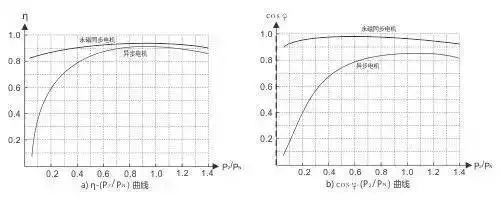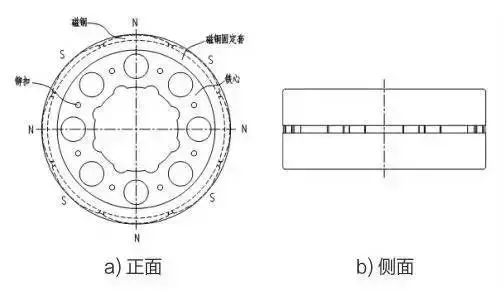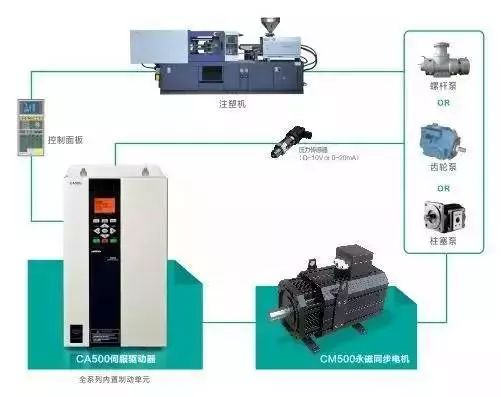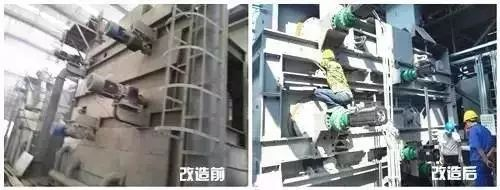Comprehensive benefit analysis of replacing asynchronous motor with permanent magnet synchronous mot
In this issue, we start from the characteristics of permanent magnet synchronous motors and combine practical applications to explain the comprehensive benefits of promoting permanent magnet synchronous motors.
Compared with asynchronous motors, synchronous motors have the advantages of high power factor, high efficiency, measurable rotor parameters, large air gap between stator and rotor, good control performance, small size, light weight, simple structure, high torque/inertia ratio, etc. It has been widely used in petroleum, chemical industry, light textile, mining, CNC machine tools, robots and other fields, and is developing towards high power (high speed, high torque), high functionality and miniaturization.
The permanent magnet synchronous motor consists of a stator and a rotor. The stator is the same as the asynchronous motor and consists of three-phase windings and a stator core. A pre-magnetized (magnetized) permanent magnet is installed on the rotor, and a magnetic field can be established in the surrounding space without external energy, which not only simplifies the structure of the motor, but also saves energy. This article starts from the characteristics of permanent magnet synchronous motors, combined with practical applications to explain the comprehensive benefits of promoting permanent magnet synchronous motors.
Outstanding advantages of permanent magnet synchronous motor
(1) Since the rotor is made of permanent magnets, the magnetic flux density is high, no excitation current is required, and excitation loss is eliminated. Compared with the asynchronous motor, it reduces the excitation current of the winding on the stator side and the copper and iron loss on the rotor side, and greatly reduces the reactive current. Due to the synchronization of the stator and rotor magnetic potential, the rotor core has no fundamental wave iron loss, so the efficiency (related to active energy) and power factor (related to reactive energy) are higher than those of asynchronous motors. Permanent magnet synchronous motors are generally designed to have high power factor and high efficiency even at light load operation.

The figure above is a comparison curve of efficiency and power factor between a permanent magnet synchronous motor and an asynchronous motor of the same specification. From the perspective of the load change of the motor, the rare earth permanent magnet synchronous motor can maintain high power factor and high efficiency in the range of 25% to 120% of the rated power, while the general three-phase asynchronous motor can only be maintained at 60% to 100% of the rated power.
(2) The permanent magnet synchronous motor has relatively hard mechanical characteristics, and has a strong ability to withstand motor torque disturbances caused by load changes. The rotor core of the permanent magnet synchronous motor can be made into a hollow structure to reduce the rotor inertia, and the starting and braking time are much faster than that of the asynchronous motor. The high torque/inertia ratio makes the permanent magnet synchronous motor more suitable for operation under fast response conditions than the asynchronous motor.

(3) The size of the permanent magnet synchronous motor is greatly reduced compared with the asynchronous motor, and the weight is also relatively light. The permanent magnet synchronous motor with the same heat dissipation conditions and insulating materials has more than 2 times the power density of the three-phase asynchronous motor.
(4) The structure of the rotor is greatly simplified, which is convenient for maintenance and improves the stability of operation.
In AC permanent magnet servo motors, the magnetic steel on the rotor and the iron core are usually bonded together with high-temperature glue. The glue curing time is generally relatively long, and during the operation of the motor, the magnetic steel may deform or even fall off under the repeated action of temperature changes and impact forces. In order to solve this technical problem, the CM500 series heavy-duty permanent magnet synchronous motor developed by Sifang changed the magnetic tile gluing process to a mechanical fastening method with a stainless steel sleeve, which completely eliminated the risk of the magnetic steel loosening. This innovative application technology has been applied for a patent, which is a great progress in motor rotor technology.

The picture shows the structure of the permanent magnet synchronous motor rotor assembly
The three-phase asynchronous motor needs to design a higher power factor, so it is necessary to make the air gap between the stator and the rotor very small. At the same time, the uniformity of the air gap is also crucial to the safe operation of the motor and the vibration and noise. For this asynchronous motor, the requirements on the shape and position tolerance of the parts and the assembly concentricity are relatively strict, and the degree of freedom in the selection of the bearing clearance is relatively small. The asynchronous motor with a large frame usually uses oil bath lubrication. The bearing must be filled with lubricating oil within the specified working time. , Bearing maintenance accounts for a large proportion. In addition, due to the existence of induced current in the rotor of three-phase asynchronous motors, the problem of electric corrosion of bearings has also been concerned by many researchers in recent years.
Permanent magnet synchronous motors do not have such problems. Due to the large air gap of the permanent magnet synchronous motor, the related problems caused by the small air gap of the above-mentioned asynchronous motor are not obvious on the synchronous motor. At the same time, the bearings of the permanent magnet synchronous motor are grease-lubricated bearings with dust covers.
Typical applications of permanent magnet synchronous motors
2.1 Application scheme of electro-hydraulic servo injection molding machine
The traditional injection molding machine uses a three-phase asynchronous motor with a quantitative pump. During the working process of the injection molding machine, the motor needs to run for a long time. Through the energy-saving transformation of the servo oil pump drive system, the quick response and large starting torque of the permanent magnet synchronous motor can start the permanent magnet synchronous motor to drive the oil pump to generate pressure when the injection molding machine needs to complete the injection molding. During the process of blanking and mold closing, the main motor of the oil pump is in a stop state, realizing intermittent zero power consumption, and the energy saving rate can reach up to 85% through comparison.
Under the control of excellent servo motor algorithm, the noise is much lower than ordinary injection molding machines. Under the ideal condition of configuring the low-noise screw pump, the noise of the injection molding machine is lower than 70 decibels, realizing silent operation and improving the working environment.

2.2 Energy-saving application on iron ore dry separator
The site of use is a mining field in Northwest China, in a dusty environment. The equipment uses a total of 125 electric motors. When the hoisting equipment is started, it needs a large starting torque. During normal operation, the motor operates at a light load state of 30% to 50% of the rated power for a long time. The efficiency of the three-phase asynchronous motor originally used is only about 65%. The power saving test statistics are as follows:


User concerns
3.1 Motor life
The service life of the entire motor depends on the service life of the bearings. The motor casing adopts the protection level of IP54, which can be increased to IP65 in special environments, which meets the requirements of most dusty and humid environments. Under the condition that the installation coaxiality of the motor shaft extension is good and the radial load of the rotating shaft is moderate, the minimum service life of the motor bearing is more than 20,000 hours. The second is the life of the cooling fan. The fan uses a single-phase 220V shaded pole motor, and its service life is longer than that of a capacitor-operated motor. When running for a long time in a dusty and humid environment, it is necessary to regularly remove the sticky substances attached to the fan to prevent the fan from being burned due to overload.
3.2 Failure and protection of permanent magnet materials
The importance of permanent magnet materials to permanent magnet motors is self-evident, and its cost accounts for nearly 1/4 of the entire motor material cost. In this regard, Sifang has formulated enterprise standards for permanent magnet materials, including corrosion resistance, consistency, high temperature demagnetization test, linear demagnetization curve test, etc. The current permanent magnet materials have been able to run for a long time under the allowable temperature rise of the motor winding limit, and the demagnetization rate is within 2%. Conventional permanent magnet materials require the surface coating to withstand a salt spray test for more than 24 hours. For environments with severe oxidation and corrosion, users need to contact the manufacturer to select permanent magnet materials with higher protection technology.
3.3 Coil burned out
The failure rate of traditional asynchronous motor coil burnout is as high as 8%, which is mainly related to the thermal protection of the motor and the quality of electrical materials. The company's CM500 series permanent magnet synchronous motor coils are embedded with heat-sensitive elements. When the temperature rise of the coil reaches the F-class insulation limit temperature rise of 105K, the driver implements overheating protection for the motor through the temperature signal collected by the heat-sensitive element to ensure the safe operation of the motor. At the same time, the motor stator adopts two vacuum dipping processes, which greatly improves the qualified rate of the stator.
epilogue
From the analysis of economic benefits: permanent magnet synchronous motors are especially suitable for heavy-start and light-running applications. The promotion and use of permanent magnet synchronous motors has positive economic and social benefits, and is of great significance to energy saving and emission reduction. In terms of reliability and stability, permanent magnet synchronous motors also have valuable advantages. The selection of high-efficiency permanent magnet synchronous motors is a one-time investment and a long-term benefit process.



























 XINDA
XINDA